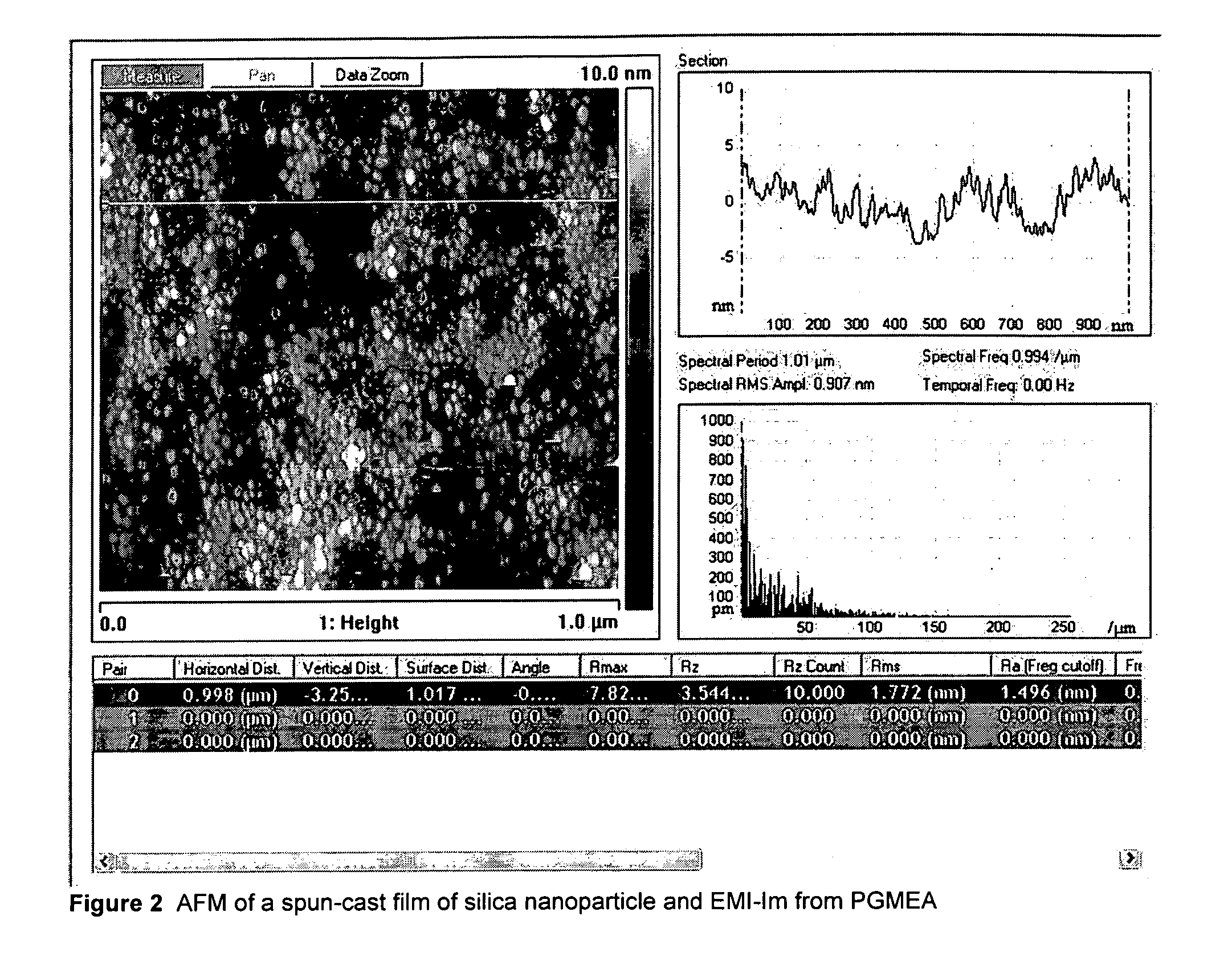Liquid Composite Compositions Using Non-Volatile Liquids and Nanoparticles and Uses Thereof
a non-volatile liquid and composite composition technology, applied in the field of gelled liquid compositions, can solve the problems of limited total particle loading of the gel, difficult to ensure a uniform pore size, and relatively difficult optimization and control of the chemistry of the gel,
- Summary
- Abstract
- Description
- Claims
- Application Information
AI Technical Summary
Benefits of technology
Problems solved by technology
Method used
Image
Examples
example 1
Thick Composite Film
[0362]To a colloidal suspension of silica particles (IPA-ST, Nissan Chemical Company of America) in iso-propyl alcohol, ionic liquid is added in an approximately 1:2 weight ratio to silica. In a preferred embodiment, the ionic liquid is ethylmethylimidazolium bis(trifluoromethylsulfonamide) (EMI-Im).
[0363]Addition of 1 part by weight EMI-Im to 2 parts by weight silica in a 30 wt % dispersion of 10-15 nm silica particles in IPA results in a clear solution, which can be cast into a Teflon pan. The solvent can be allowed to dry at room temperature, or the system can be heated to 6° C. to facilitate the removal of IPA. The resulting transparent film can be removed from the bottom of the pan with tweezers or a spatula, and handled as a free-standing material.
[0364]Addition of significantly less EMI than reported above results in a more brittle material that cracks on drying. Addition of significantly more EMI than reported above results in a paste that cannot be dried...
example 2
Thin Composite Film
[0376]To a colloidal suspension of silica particles (pH=2-4) in organic solvent, ionic liquid is added in an approximately 1:2 weight ratio to silica. In a preferred embodiment, the ionic liquid is ethylmethylimidazolium bis(trifluoromethylsulfonamide) (EMI-Im).
[0377]Addition of 1 part by weight EMI-Im to 2 parts by weight silica in a 30 wt % dispersion of 10-15 nm silica particles in PGMEA results in a clear solution. To each gram of this stock solution is added 1.077 g of PGMEA. The solution is mixed by stirring.
[0378]The solution can be spun between 1500 and 8000 rpm onto a 2″ silicon wafer. At 4000 rpm, this film gives an approximately 2500 A thick film. The stock solution itself can be spun as low as 1500 rpm to give a film up to 1.2 um in thickness.
[0379]The films are extremely uniform by ellipsometry, and show an rms roughness of <2 nm by AFM. Individual silica particles can be resolved by AFM, and are tightly packed (though not ordered) (FIG. 2). The condu...
example 3
Thick Film Using Crosslinking Agent
[0380]To a colloidal suspension of silica particles (pH=2-4) in PGMEA (2 g) is added EMI-Im (300 mg) and dicyclohexylmethane diisocyanate (0 mg, 16 mg, or 161 mg) as a cross-linking agent. The solution is mixed until homogenous, and spun onto a comb structure to a thickness of about 1 micron, then baked at 90° C. for 3 minutes and 140° C. for 1 hour.
[0381]The conductivity is measured by AC impedence spectroscopy, and the modulus is measured by dynamic nanoindentation. In the case with no added crosslinker, the conductivity is 1.07 mS / cm, and the modulus is approximately 700 MPa, though because of the type of measurement, this may represent an upper bound. In the case with only 16 mg crosslinker, the conductivity drops slightly to 0.85 mS / cm, and the modulus increases to about 2 GPa. In the case with 161 mg crosslinker, the conductivity drops further to 0.39 mS / cm, and the modulus increases to over 4 GPa.
[0382]Similar results can be obtained using o...
PUM
| Property | Measurement | Unit |
|---|---|---|
| diameter | aaaaa | aaaaa |
| diameter | aaaaa | aaaaa |
| cross-sectional diameter | aaaaa | aaaaa |
Abstract
Description
Claims
Application Information
 Login to View More
Login to View More - R&D
- Intellectual Property
- Life Sciences
- Materials
- Tech Scout
- Unparalleled Data Quality
- Higher Quality Content
- 60% Fewer Hallucinations
Browse by: Latest US Patents, China's latest patents, Technical Efficacy Thesaurus, Application Domain, Technology Topic, Popular Technical Reports.
© 2025 PatSnap. All rights reserved.Legal|Privacy policy|Modern Slavery Act Transparency Statement|Sitemap|About US| Contact US: help@patsnap.com



